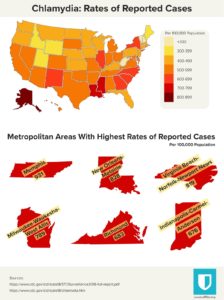U.S. Chlamydia Rates by State
 Chlamydia is a common STD and is one of the most common notifiable diseases in the United States. Many people with chlamydia don’t develop symptoms, but those who do may experience genital discharge and pain during urination.
Chlamydia is a common STD and is one of the most common notifiable diseases in the United States. Many people with chlamydia don’t develop symptoms, but those who do may experience genital discharge and pain during urination.
Left untreated, chlamydia can cause serious and permanent damage to the reproductive system. The infection can spread into the uterus and fallopian tubes, leading to pelvic inflammatory disease (PID). PID can cause chronic pain, ectopic pregnancy, and infertility.
While chlamydia affects people of all ages, it most commonly affects young women. Antibiotic therapy is recommended for both those who are infected, as well as their sexual partners.
In 2018, there were a total of 1,758,668 chlamydial infections reported to the U.S. Centers for Disease Control and Prevention (CDC). Cases increased by 2.9% since 2017 from 524.6 to 539.9 cases per 100,000 people. Rates of reported cases by state in 2018 ranged from 198.2 cases per 100,000 people in West Virginia to 832.5 cases per 100,000 in Alaska.
In 2018, the chlamydia rate for the District of Columbia was 1,298.9 cases per every 100,000 people.
Although chlamydia rates increased across all regions in the last decade, rates of reported cases were highest in the South (565.2 cases per 100,000) followed by the West (548.5), Midwest (524.0), and Northeast (492.1). Chlamydia rates are especially high in metropolitan areas where populations are higher.
Per every 100,000 people, the metropolitan areas in the U.S. with the highest chlamydia rates include:
- Memphis, TN (931)
- New Orleans/Metairie, LA (828)
- Virginia Beach/Norfolk/Newport News, VA (819)
- Richmond, VA (683)
- Milwaukee/Waukesha/West Allis, WI (789)
- Indianapolis/Carmel/Anderson, IN (676)
According to the annual Sexually Transmitted Disease Surveillance Report released by the CDC in October 2019, chlamydia rates are currently at an all-time high due to lack of funding for STI prevention programs, a drop-off in condom use, and a lack of awareness about the disease. Other contributing factors to the increase in chlamydia include poverty and unstable housing, which can reduce access to STD prevention and care.
Because those with chlamydia often don’t experience symptoms, it’s easy for those who are affected by the disease to put off going to see a doctor. But it’s essential to undergo STD testing regularly if you’re sexually active to keep yourself and your partners safe. The U.S. Department of Health and Human Services is developing a Sexually Transmitted Infections (STI) Federal Action Plan (STI Plan) to address and reverse the chlamydia problem in the United States.
Leave a reply